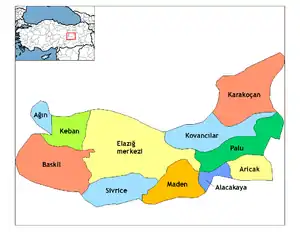Elazığ Province
Elâzığ Province (Turkish: Elâzığ ili, Zazaki: Suke Xarpêt[2] Kurdish: Parêzgeha Xarpêtê[3]) is a province of Turkey with its seat in the city of Elâzığ. The province had a population of 568,753 in 2014. The population of the province was 569,616 in 2000 and 498,225 in 1990. The total area of the province is 8,455 square kilometres (3,264 sq mi), 826 km2 (319 sq mi) of which is covered by reservoirs and natural lakes. The current governor of the province is Çetin Oktay Kaldirim.[4]
Elâzığ Province
Elazığ ili | |
|---|---|
 Location of Elâzığ Province in Turkey | |
| Country | Turkey |
| Region | Central East Anatolia |
| Subregion | Malatya |
| Government | |
| • Electoral district | Elâzığ |
| • Governor | Erkaya Yırık |
| Area | |
| • Total | 8,455 km2 (3,264 sq mi) |
| Population (2018)[1] | |
| • Total | 595,638 |
| • Density | 70/km2 (180/sq mi) |
| Area code(s) | 00424 |
| Vehicle registration | 23 |
| Website | elazig.gov.tr |
History
In 1927 the office of the Inspector General was created, which governed with martial law.[5] The province was included in the first Inspectorate General (Umumi Müfettişlik, UM) over which the Inspector General ruled. The UM span over the provinces of Hakkâri, Siirt, Van, Mardin, Bitlis, Sanlıurfa, Elaziğ and Diyarbakır.[6] In December 1935, the Tunceli Law was passed, which demanded a more powerful Government in the region.[7] In January 1936 the Elaziğ province was transferred under the authority of the newly established Fourth Inspectorate General, which span over the provinces of Elaziğ, Erzincan, Bingöl and Tunceli[8] and its seat was in the city of Elazığ.[9] The fourth UM was governed by a Governor-Commander. Most of the employees in the municipalities had to be from the military and the Governor-Commander had the authority to evacuate whole villages and resettle them in another part of the province.[10] In 1946 the Tunceli Law was abolished and the state of emergency removed but the authority of the fourth UM was transferred to the military.[10]
The Inspectorates General were dissolved in 1952 during the Government of the Democrat Party.[11]
The province had experienced a 6.7 richter earthquake on 24 January 2020.[12]
Geography
Elâzığ stretches in a general west-southwest to east-northeast direction, along the line of equal geographic latitude and longitude. The source of the Euphrates river is located in this province.
Economy
Historically, Elazığ Province produced silver, which ceased being mined in 1885. The Turkish government attempted to modernize the mines; however, the cost of fuel and energy caused the shut down. There was a silver mine still producing in 1903 in Palu, as with coal. Coal is also found in other areas of the province. Gold and salt was also produced.[13]
Education
Education is provided by the Elâzığ Provincial Directorate for National Education. It currently views over 442 educational institutions, both formal and informal ones.[14]
Archaeology
Altinova, Elazig was an important archaeological site in the Altınova plain that was excavated in the 1970s. It was later flooded by the Keban Dam. Other sites in the Altinova plain were also Tepecik, Korucutepe, Değirmentepe, and Körtepe.
References
- "Population of provinces by years - 2000-2018". Turkish Statistical Institute. Retrieved 9 March 2019.
- Zazaca -Türkçe Sözlük, R. Hayıg-B. Werner
- "Li Wanê taxek hat kerentînekirin" (in Kurdish). Rûdaw. 8 April 2020. Retrieved 27 April 2020.
- "Elazığ Valisi Çetin Oktay KALDIRIM". www.elazig.gov.tr. Retrieved 2020-04-08.
- Jongerden, Joost (1 January 2007). The Settlement Issue in Turkey and the Kurds: An Analysis of Spatical Policies, Modernity and War. BRILL. p. 53. ISBN 978-90-04-15557-2.CS1 maint: date and year (link)
- Bayir, Derya (2016-04-22). Minorities and Nationalism in Turkish Law. Routledge. p. 139. ISBN 978-1-317-09579-8.
- Cagaptay, Soner (2 May 2006). Islam, Secularism and Nationalism in Modern Turkey: Who is a Turk?. Routledge. pp. 108–110. ISBN 978-1-134-17448-5.
- Cagaptay (2006), p.110
- Soner Çaǧaptay, Islam, Secularism, and Nationalism in Modern Turkey: Who is a Turk?, Taylor & Francis, 2006, ISBN 978-0-415-38458-2, p. 48
- Bayir, Derya (2016-04-22). Minorities and Nationalism in Turkish Law. Routledge. pp. 139–141. ISBN 978-1-317-09579-8.
- Fleet, Kate; Kunt, I. Metin; Kasaba, Reşat; Faroqhi, Suraiya (2008-04-17). The Cambridge History of Turkey. Cambridge University Press. p. 343. ISBN 978-0-521-62096-3.
- "M 6.7 - 13km N of Doganyol, Turkey". earthquake.usgs.gov. Retrieved 2020-04-01.
- Prothero, W.G. (1920). Armenia and Kurdistan. London: H.M. Stationery Office. p. 74.
- Solmaz, Remzi (2015-12-14). "Elazig City Department Of Education". EPALE - European Commission. Retrieved 2020-05-23.
External links
| Wikimedia Commons has media related to Elâzığ Province. |
- (in Turkish) Elâzığ governor's official website
- (in Turkish) Elâzığ municipality's official website
- (in English) Elâzığ weather forecast information



